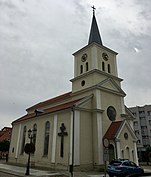|
Sztum
Sztum ([ʂtum]) (formerly German: Stuhm) is a town in northern Poland in the Powiśle region, located in the Pomeranian Voivodeship. It is the capital of Sztum County, with some 10,141 inhabitants (2004). History Signs of settlement dating back to the Roman Empire era have been found. In the early Middle Ages, a fortified settlement of the Old Prussians existed at the site, conquered by the Teutonic Knights in 1236. The castle was captured by the Poles after the Battle of Grunwald in 1410.[1] Town rights were granted to the settlement in 1416 and confirmed by King Sigismund II Augustus in 1553.[2] In 1441 both the town and the local Teutonic county official joined the Prussian Confederation, which opposed Teutonic rule,[3] and upon the request of which King Casimir IV Jagiellon incorporated the territory to the Kingdom of Poland in 1454. The castle, which initially remained in the hands of the Teutonic Knights, was captured by Poles after a siege in 1454, but later it was taken over by the Teutonic Knights again.[2] In 1466 by the Second Peace of Toruń the town was finally renounced by the Teutonic Knights[4] and integrated with the Kingdom of Poland. As part of Poland, the town functioned as a seat of the Sztum County in Malbork Voivodeship and a place to hold the voivodeship's sejmiks (regional court sessions). The Sztum Castle was the seat of the local starosts. In 1506 and 1512 the town was visited by Nicolaus Copernicus,[5] and in 1552 it was visited by Polish King Sigismund II Augustus.[6]  In 1772 as a result of the First Partition of Poland the town was annexed by the Kingdom of Prussia. In October–December 1831, some Polish infantry units and intendant troops of the November Uprising stopped in the town on the way to their final internment places.[7] In 1871, it became part of the newly created German Empire. In 1910, the Polish Bank Ludowy was founded in the town.[8] According to the Treaty of Versailles, after World War I the inhabitants of the town and its district were asked whether they want to remain in Germany or join the new Second Polish Republic in the East Prussian plebiscite of 1920. Ultimately in Stuhm, 2,079 (73.5%) votes were cast in favor of remaining in Germany and 751 (26.5%) votes were in favor of rejoining Poland.[9] Based on that result, Stuhm was included in the Regierungsbezirk Marienwerder within East Prussia in Germany. In the interwar period, Sztum remained one of the main centers of the Polish community in the area. The Germans arrested 30 local Polish activists in August 1939, before the invasion of Poland which started World War II.[10] During the war, the Germans operated a Nazi prison in the town.[11] After World War II, Sztum again became part of Poland, under territorial changes demanded by the Soviet Union at the Potsdam Conference. On 14 July 2012 the town and surrounding areas, including Barlewice, were hit by a Low-End F3/T6 tornado, resulting in one injury. Buildings saw significant roof damage, some of which were entirely torn off. Other buildings were damaged as well. The tornado was part of an outbreak that produced several tornadoes, one of which killed a person.[12][13][14][15] Number of inhabitants by year
Historic churches in Sztum Saint Anne Our Lady Help of Christians TransportThe Polish National road 55 and Voivodeship road 517 pass through the town, and there is also a train station. Sports Local sports clubs include football club Olimpia Sztum,[20] which competes in the lower leagues, and athletics club Zantyr Sztum.[21] Notable residents
International relationsSztum is twinned with:
References
External links |
||||||||||||||||||||||||||||||||||||||||||||||||||||||||||||||||||||||||||||||||||||||||||||







